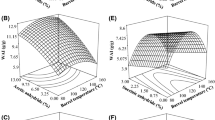Abstract
This study investigated the impact of starch proteins on the hydroxypropylation and acetylation of rice starch. Hydroxypropylated (HP) and acetylated (AC) starches were synthesized using rice starch prepared by protease digestion with and without purification. The protein content of purified starch (CONP) was not changed by derivatization, but that of crude starch without purification (COPR) decreased. The reactivity was slightly lower in HP-COPR but were identical between AC-starches. The relative crystallinity was higher for HP-COPR and AC-COPR. HP-COPR and AC-COPR showed lower swelling power and solubility than HP-CONP and AC-CONP, respectively. Higher gelatinization enthalpies were observed in modified starches from COPR. Pasting viscosities were similar between HP-starches and were higher in AC-CONP than in AC-COPR. Overall, COPR is a potential source of chemically modified starches with a reduced production cost; however, it should be noted that the starch protein content affects the reactivity and physical functionality of modified starches.



Similar content being viewed by others
References
AACC. Approved Method of the AACC. 10th ed. Method 46-08. American Association of Cereal Chemists, St. Paul, MN, USA (2000)
Ashogbon AO, Akintayo ET. Recent trend in the physical and chemical modification of starches from different botanical sources: A review. Starch-Stärke. 66: 41-57 (2014)
Bae JE, Hong JS, Baik MY, Choi HD, Choi HW, Kim HS. Impact of starch granule-associated surface and channel proteins on physicochemical properties of corn and rice starches. Carbohydrate Polymers. 250: 116908 (2020)
Bae JE, Hong JS, Choi HD, Kim YR, Baik MY, Kim HS. Impact of starch granule-associated channel protein on characteristic of and λ-carrageenan entrapment within wheat starch granules. International Journal of Biological Macromolecules. 174: 440-448 (2021)
BeMiller JN. Starch modification: Challenges and prospects. Starch-Stärke. 49: 127-131 (1997)
Biliaderis CG. Physical characteristics, enzymatic digestibility, and structure of chemically modified smooth pea and waxy maize starches. Journal of Agricultural and Food Chemistry. 30: 925-930 (1982)
Chrastil J. Improved colorimetric determination of amylose in starches or flours. Carbohydrate Research. 159: 154-158 (1987)
Colussi R, Pinto VZ, El Halal SLM, Vanier NL, Villanova FA, Silva RME, Zavareze EDR, Dias ARG. Structural, morphological, and physicochemical properties of acetylated high-, medium-, and low-amylose rice starches. Carbohydrate Polymers. 103: 405-413 (2014)
El-Adawy TA. Functional properties and nutritional quality of acetylated and succinylated mung bean protein isolate. Food Chemistry. 70: 83-91 (2000)
Han JA. Pasting properties of hydroxypropylated starches before or after proteinase treatment. Starch-Stärke. 62: 257-261 (2010)
Han JA, BeMiller JN. Effects of protein on crosslinking of normal maize, waxy maize, and potato starches. Carbohydrate Polymers. 73: 532-540 (2008)
Hasanov EE, Rahimov RA, Abdullayer Y, Asadov ZH, Ahmadova GA, Isayeva AM, Ahmadbayova SF, Zubkov FI, Autschbach J. New class of cocogem surfactants based on hexamethylenediamine, propylene oxide, and long chain carboxylic acids: Theory and application. Journal of Industrial and Engineering Chemistry. 86: 123-135 (2020)
Huang J, Zhang P, Chen Z, Li H. Characterization of remaining granules of acetylated starch after chemical surface gelatinization. Carbohydrate Polymers. 80: 215-221 (2010)
Jyothi AN, Moorthy SN, Rajasekharan KN. Studies on the synthesis and properties of hydroxypropyl derivatives of cassava (Manihot esculenta Crantz) starch. Journal of the Science of Food and Agriculture. 87: 1964-1972 (2007)
Kim HS, Choi HS, Kim BY, Baik MY. Characterization of acetylated corn starch prepared under ultrahigh pressure (UHP). Journal of Agricultural and Food Chemistry. 58: 3573-3579 (2010)
Kim HS, Choi HS, Kim BY, Baik MY. Ultra high pressure (UHP)-assisted hydroxypropylation of corn starch. Carbohydrate Polymers. 83: 755-761 (2011)
Kim HS, Huber KC. Impact of A/B-type granule ratio on reactivitiy, swelling, gelatinization, and pasting properties of modified wheat starch. Part I: Hydroxypropylation. Carbohydrate Polymers. 80: 94-104 (2010)
Kim HS, Huber KC. Reaction patterns of wheat starch granules substituted with an anionic propylene oxide analog (POA) revealed by confocal microscopy and 3D anaglyph imaging. Carbohydrate Polymers. 95: 492-500 (2013)
Kim R, Kim HS. Development and characterization of potato amylopectin-substituted starch materials. Food Science and Biotechnology. 30: 833-842 (2021)
Kim R, Lim S, Kim HS. Production and characterization of rice starch from stale rice using improved enzymatic digestion method. Korean Journal of Food Science and Technology. 53: 749-755 (2021)
Lee SJ, Hong JY, Lee EJ, Chung HJ, Lim ST. Impact of single and dual modifications on physicochemical properties of japonica and indica rice starches. Carbohydrate Polymers. 122: 77-83 (2015)
Lee H, Kim HS. Pasting and paste properties of waxy rice starch as affected by hydroxypropyl methylcellulose and its viscosity. International Journal of Biological Macromolecules. 153: 1202-1210 (2020)
Lumdubwong N, Seib PA. Rice starch isolation by alkaline protease digestion of wet-milled rice flour. Journal of Cereal Science. 31: 63-74 (2000)
Puchongkavarin H, Varavinit S, Bergthaller W. Comparative study of pilot scale rice starch production by an alkaline and an enzymatic process. Starch-Stärke. 57: 134-144 (2005)
Shen Y, Zhang N, Xu Y, Huang J, Yuan M, Wu D, Shu X. Physicochemical properties of hydroxypropylated and cross-linked rice starches differential in amylose content. International Journal of Biological Macromolecules. 128: 775-781 (2019)
Singh J, Kaur L, McCarthy OJ. Factors influencing the physico-chemical, morphological, thermal and rheological properties of some chemically modified starches for food applications-A review. Food Hydrocolloids. 21: 1-22 (2007)
Tester RF, Karkalas J, Qi X. Starch-composition, fine structure and architecture. Journal of Cereal Science. 39: 151-165 (2004)
Zhu L, Zhang Y, Wu G, Qi X, Dag D, Kong F, Zhang H. Characteristics of pasting properties and morphology changes of rice starch and flour under different heating modes. International Journal of Biological Macromolecules. 149: 246-255 (2020)
Acknowledgements
This work was supported by Kyonggi University Research Grant 2019.
Author information
Authors and Affiliations
Corresponding author
Ethics declarations
Conflict of interest
The authors declare no conflict of interest.
Additional information
Publisher's Note
Springer Nature remains neutral with regard to jurisdictional claims in published maps and institutional affiliations.
Supplementary Information
Below is the link to the electronic supplementary material.
Rights and permissions
About this article
Cite this article
Choi, H.W., Kim, HS. Hydroxypropylation and acetylation of rice starch: effects of starch protein content. Food Sci Biotechnol 31, 1169–1177 (2022). https://doi.org/10.1007/s10068-022-01106-y
Received:
Revised:
Accepted:
Published:
Issue Date:
DOI: https://doi.org/10.1007/s10068-022-01106-y




